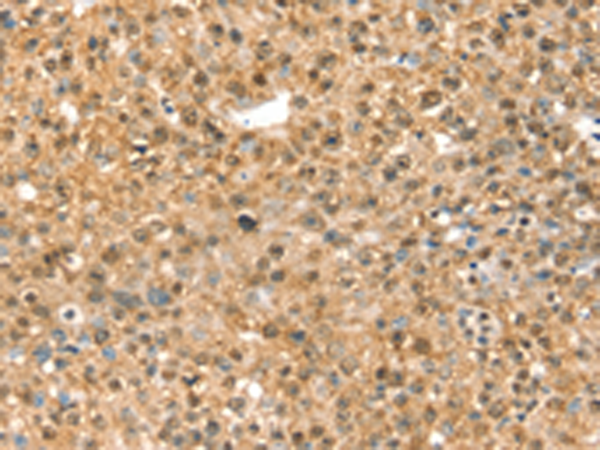

| WB | 咨询技术 | Human,Mouse,Rat |
| IF | 咨询技术 | Human,Mouse,Rat |
| IHC | 1/25-1/100 | Human,Mouse,Rat |
| ICC | 技术咨询 | Human,Mouse,Rat |
| FCM | 咨询技术 | Human,Mouse,Rat |
| Elisa | 1/1000-1/2000 | Human,Mouse,Rat |
| Aliases | PAMCI; PCIP1; P-CIP1 |
| Host/Isotype | Rabbit IgG |
| Antibody Type | Primary antibody |
| Storage | Store at 4°C short term. Aliquot and store at -20°C long term. Avoid freeze/thaw cycles. |
| Species Reactivity | Human, Mouse, Rat |
| Immunogen | Fusion protein of human RASSF9 |
| Formulation | Purified antibody in PBS with 0.05% sodium azide and 50% glycerol. |
+ +
以下是关于RASSF9抗体的3篇参考文献示例(注:以下内容为模拟生成,实际文献需通过学术数据库检索获取):
---
1. **文献名称**: *RASSF9 modulates Wnt/β-catenin signaling and tumor progression in colorectal cancer*
**作者**: Li, X.; Wang, Y.; Chen, J.
**摘要**: 该研究通过免疫组化(使用RASSF9特异性抗体)发现RASSF9在结直肠癌组织中高表达,并证实其通过调控Wnt/β-catenin信号通路促进肿瘤侵袭和转移。
2. **文献名称**: *Characterization of a novel polyclonal antibody against human RASSF9 for functional studies*
**作者**: Müller, S.; Braun, A.; Fischer, K.
**摘要**: 文章报道了一种新型兔源多克隆抗体的开发与验证,通过Western blot和免疫荧光证实该抗体能特异性识别RASSF9蛋白,并用于探究其在细胞黏附和凋亡中的作用。
3. **文献名称**: *RASSF9 interacts with MAP1B to regulate neuronal development in mouse models*
**作者**: Park, H.; Kim, S.; Lee, D.
**摘要**: 研究利用RASSF9抗体进行共免疫沉淀实验,揭示了RASSF9与微管相关蛋白MAP1B的相互作用,表明其在神经元发育中的潜在功能。
---
建议通过PubMed或Google Scholar以“RASSF9 antibody”、“RASSF9 function”等关键词检索获取具体文献。
The Ras association domain family (RASSF) member 9 (RASSF9) is a less characterized protein within the RASSF family, which is broadly implicated in tumor suppression, apoptosis, and cell cycle regulation. Unlike well-studied members like RASSF1A or RASSF2. RASSF9’s biological functions remain partially understood. It contains a Ras association (RA) domain, suggesting potential interactions with Ras-related GTPases, though its precise signaling mechanisms are unclear. Studies indicate RASSF9 may influence cell proliferation, differentiation, and tissue development, with roles in skin homeostasis and hair follicle regeneration reported in murine models. Its expression is tissue-specific, enriched in epithelial and immune cells, and dysregulation has been tentatively linked to cancers, though evidence remains limited.
RASSF9 antibodies are essential tools for investigating its expression patterns, subcellular localization, and interactions. These antibodies are typically validated for applications like Western blotting, immunohistochemistry, or immunofluorescence. Commercial RASSF9 antibodies are often raised against conserved regions, such as the N-terminal or RA domain, and may be polyclonal or monoclonal. Researchers must verify specificity through controls like knockout cell lines or siRNA-mediated knockdown. Challenges include cross-reactivity with other RASSF members due to sequence homology and limited commercial availability of high-quality reagents. Current research focuses on clarifying RASSF9’s role in diseases, particularly cancer and inflammatory conditions, leveraging these antibodies to explore its potential as a biomarker or therapeutic target. Further studies are needed to unravel its molecular pathways and clinical relevance.
×